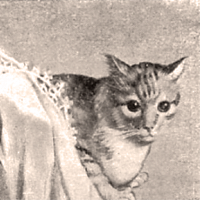Records of her possessions after her death suggest that the Florentine Queen of France Catherine de Medici herself embroidered on Buratto perhaps bringing it with her from Italy (for more info see my article in Piecework Nov/Dec 2010).
Until quite recently this fabric was only made in a small town in Tuscany using the special ancient loom required to weave it. The art of embroidery on Buratto had all but died out.
On a recent visit to the Fondazione Lisio, I was pleasantly surprized to discover that they had plans to acquire one of these very rare specialized looms and begin to weave Buratto fabric in the ancient style.
This is so new to them that they have not yet had time to translate the page in English on their website, so I'll give you a quick translation of what it says:
"Buratto netting at the Lisio Foundation
Among the reproductions of ancient weaving techniques that the Lisio Foundation boasts in its long history, there is now a new one: Buratto netting.
The term derives from the Latin bura (coarse cloth) and indicates a fabric produced on a loom and consisting of a more or less open weave depending on its intended use as either a sieve used in silk or flour production or, if made with finer threads, as the base for hand embroidery. Evidence of embroidered Buratto dates back to the sixteenth century and to 1527 and the oldest Italian extant book of patterns: The burato: book of embroidery by Alessandro Paganini (ed. Venice, Paganini).
This ancient textile technique of both weaving and embroidery, was revived at the beginning of the twentieth century by the ladies Virginia Nathan and Clara Onori of Antella (a hamlet of Bagno a Ripoli near Florence), founding a school with the aim of providing a source of livelihood which would help relieve the domestic economy of the area.
Today at the Foundation alongside the Jacquard looms on which our master weavers create fine velvets and brocades, there is a loom, just as important as the others, on which Buratto netting is hand woven thus continuing a local tradition that was almost lost."
| Photo copyright Fondazione Lisio Arte della Seta, Firenze. |
You can watch a video of how it's made on YouTube.
In 1989, there was a booklet produced to document the recent history of the revival of Buratto embroidery in the early 20th century and the activity it enjoyed throughout the later half of the century called: La Tradizione del Buratto all'Antella [The Tradition of Buratto in Antella]. This book is extremely rare and difficult to find but packed with photos of embroideries of the period including some which were prize winning entries in local exhibitions. It is also a catalogue of the show held in Antella at the time.
It is the most information I've ever seen written on Buratto and it's related history.
Here is a close up of what a piece I have looks like, this was purchased from the Fil-Mec booth at the Italia Invita Forum 2011 and to the best of my knowledge was not woven at the Fondazione Lisio but by a woman in Tuscany working on her own ancient loom.
Heartfelt thanks to Ebe Ciampalini Balestri without whom I would never have seen the book described above.
Thank you Giovanna for the heads up!







1. All is very interesting!!!
ReplyDelete2. Question:
I saw old book (a pattern book released about 1527 by Alessandro Paganino) and can not understand... Almost a half of this book - pictures of mesh, grid, which slightky vary by size. Reason for it? Somethig goes wrong?
3. My excuses - my english is very bad...
I saw video about making buratto net (http://www.youtube.com/watch?v=3Ezk76q-a9I). Such a mistery! Enigma!
ReplyDeleteI have broken my head :) but ca not understand, how fils of the warp can interchange their places.
But some information is clear, although we can not see, how this wonderful loom is costructed...
I will continue to breake my head...
Do you know the principle of this loom?
There exist some literature about it? Some more information is available?
As I understand it, those pages were left intentionally blank for the embroiderer to use when charting their own patterns.
ReplyDeleteOh, I think your guess is true. Simple and reasonable.
DeleteThank you!
I'm sorry, I'm not a weaver, but you might try contacting the Fondazione Lisio for more information. I believe they have educational programs.
ReplyDeletehttp://www.fondazionelisio.org/index.php?contatti-orari
I`m not a weaver too, but I am always very curious about techniques:)
DeleteYesterday I could not sleep after this video. The quality is very poor, but some iimportant information can be extracted...
I was thinking 2 hours instead of sleeping and at last I have find one of possible solutions. I did small drawing by pencil, returned to my bed and fall asleep at last! Now I want to make this in practice - a small model, sample. To verify my guess...
In russian folk embroidery there are similar nets, woven on the loom. Such examples are rare enough, but very interesting. So it was very interestig to me, how it can be done practically. Now I am very glad to be so near solution. Thank you very much!
I will not go to Italy for this enigma - it is easier to force my head to work :)))
Thank you very much - your blog is very-very interesting. This video gave me a hint :)))
Perhaps it will be interesting for you:
ReplyDeleteThis book "The art of emdroiderer" was published in Russia in 2004 and contains some pictures of antiques italian embroideries from Hermitage State Museum:
https://www.hermitageshop.org/store/index.php?main_page=product_info&products_id=3358